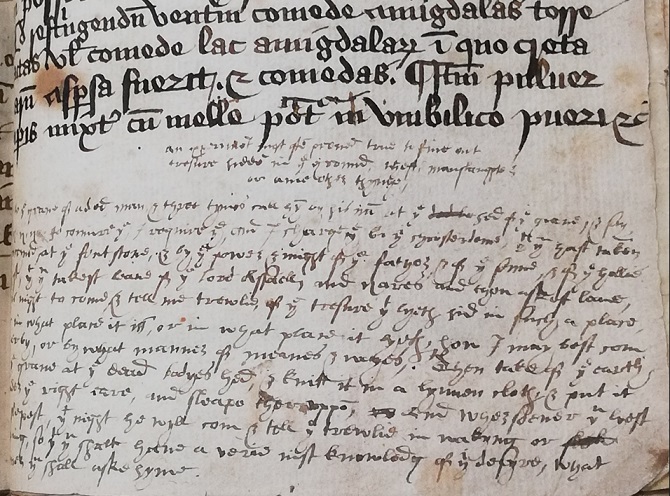Generally, the week of the New Year brings with it advice on losing weight, getting organized, setting goals, and jump-starting your life. So, why not try something totally different? Conjuring spirits.
Now, I actually don’t recommend that you conjure spirits – just as I don’t recommend that you use a Ouija board because you never know who you are reaching out to and contacting. However, this “New Year’s Eve Ghost Story” written in 1931 by Montague Rhodes James (who some consider to be the Father of Ghost Stories) was too good to pass over.
The Cambridge University Library Special Collections did an article about the story on December 31, 2022.
In a story published in the London newspaper The Morning Post, James wrote The Experiment, which was subtitled “New Year’s Eve Ghost Story,” and published it on December 31, 1931.
This is from the Cambridge Library site, “The story tells of the fate of Joseph Calvert and his mother ‘Madam Bowles’ after their stepfather and second husband, Squire Francis Bowles, dies under mysterious circumstances. Although the latter was a wealthy landowner in life, his sole heirs, mother and son, cannot find a trace of his money. While searching for clues in his stepfather’s papers, Joseph discovers an unsent letter in which the Squire describes an experiment from a medieval manuscript that had been sent to him by John Moore (1646–1714), Bishop of Norwich. The experiment describes a ritual through which one can communicate with the soul of a dead individual. Hoping to learn about the whereabouts of the Squire’s treasure, Joseph follows the ritual and summons his stepfather’s soul. But the decomposing face that meets him terrifies him too much to learn anything useful from the vision. Feeling haunted, both he and his mother sail from England to ‘Holland.’ But they are followed by an ominous hooded figure. There is clearly no escape from the invoked spectre of the Squire. Records from Norwich, James concludes, suggest that mother and son eventually returned to England and, after confessing to having murdered Squire Bowles by poisoning, were executed for their crime.”
Remember what I said about not knowing who you’re reaching out to?
And, really, if you’re going to murder someone, you probably shouldn’t summon them back from the grave.
But what’s really interesting about James’ article is that he actually reveals the ritual which was copied from a medieval manuscript.
Here’s the recipe, er, I mean, the ritual:
Step One: Go to a dead person’s grave. Call their name three times (kind of like Beetlejuice) and command them to ask permission from two angels called “Raffaell” and “Nares” to come to you that night and answer your questions.
Step Two: Take some of the earth (dirt) from their grave and wrap it in a linen cloth. Then, place the wrapped dirt-filled cloth underneath your pillow before you go to bed.
If you’ve done everything correctly, the soul of the dead person will then visit you that night, either while you are asleep or awake. (Like anyone could sleep with a dead man’s dirt under their pillow.)
But there’s a slight catch. You know when you ask for a secret family recipe and the person “accidentally” leaves out one of the ingredients or changes it slightly, to protect the family secret? Well, it seems that sixteenth-century medieval ritual was copied from a fifteenth-century collection of medical recipes, and, oopsie, it looks like they substituted one of the angels’ names. The first angel, “Raffaell,” who you could easily assume might be the Archangel Raphael (a good guy), was substituted for “Assaell.” No big deal, right? Unless you realize that Assaell almost certainly refers to Azazel, a fallen angel who is actually demonic.
The Cambridge Library says this about the mistake, “James’s misidentification of the spirit may have prevented modern scholars from identifying the text … as a copy of a widely disseminated magical work on the practice of communicating with the spirits of the dead—also known as necromancy. Our copy, for example, is not listed in a 2019 article by Daniel Harms (‘“Thou Art Keeper of Man and Woman’s Bones” – Rituals of Necromancy in Early Modern England’, Thanatos, 8:1 (2019), 62-90) in which he identifies the very same ritual in no less than fifteen fifteenth- and sixteenth-century English collections of magical texts. Importantly, Harms notes that despite variations between these copies, they all agree that the spirit’s name is Azazel, who, in some cases, is referred to as the ‘King of the dead’ and ‘Keeper of the bones of the dead’.”
So, hopefully, the lessons we’ve learned this week:
- Don’t murder people.
- Certainly, don’t murder people and then try and bring them back to find out where they hid their money.
- Don’t sleep with dead people’s dirt under your pillow.
- And don’t conjure spirits because you just might get a demon who follows you to Holland…or wherever.
Happy New Year!!!
And Happy Friday!!!
